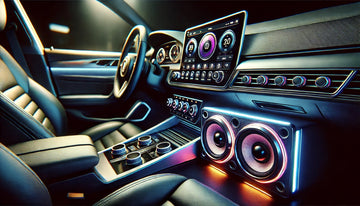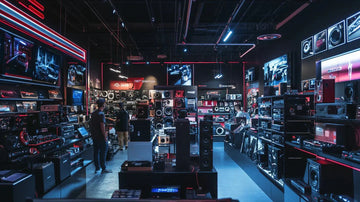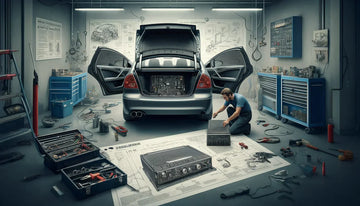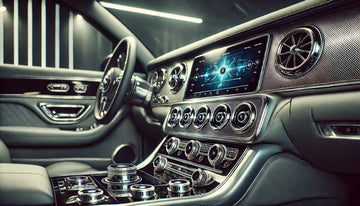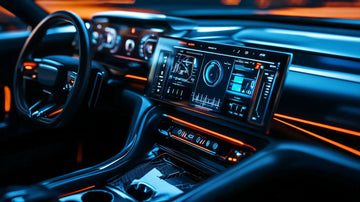Key Highlights
Discover the essential components of a car audio system and how they work together for an immersive listening experience.
- Learn about the different types of audio systems available, from basic factory setups to high-end aftermarket options.
- Get a step-by-step guide to enhancing your car audio, from assessing your current setup to choosing the right components.
- Find valuable tips and tricks for installation, ensuring optimal performance and longevity of your upgraded system.
- Explore frequently asked questions to address common queries and gain further insights into the world of car audio.
Introduction
A good car audio system can make your daily drive or trip much better. Technology has improved a lot, and car audio has changed a lot too. Now, there are many ways to boost sound quality and connect your devices. If you love music and want great sound or just want to enjoy your tunes more, it's important to understand car audio systems.
Understanding Audio Systems in Cars
Car audio systems aim to give you entertainment and information while you drive. They are different from home audio systems because they deal with loud road noise, engine vibrations, and tricky sound conditions inside the car.
To give you great sound quality, car audio systems have different parts that work well together. These parts include the head unit, speakers, amplifiers, subwoofers, and wiring. Each part helps to make your listening experience better.
The Basics of Car Audio Systems
The heart of every car audio system, often considered the centerpiece of any car audio system, is the head unit, also called the car stereo. This part is the main control center. It receives audio signals from different sources like the radio, CD players, Bluetooth devices, and auxiliary inputs. Then, it processes these signals and sends them to the amplifiers.
Car speakers turn these amplified audio signals into the best car audio sound waves. A typical car audio system has tweeters for high sounds, midrange speakers for middle frequencies, and woofers for low sounds. To get a balanced sound, you need to choose speakers that work well together and fit the vehicle’s sound properties.
Brands like JL Audio and JBL are famous for their quality car audio parts. They provide many speakers, amplifiers, and subwoofers that are known for great sound and durability. This makes them a top choice for people who love car audio.
Types of Audio Systems and Their Components

Car audio systems are mainly divided into two types: factory-installed systems and aftermarket systems. Factory-installed systems are set up by the car maker and usually offer basic audio features. Aftermarket systems, however, allow for more customization and can deliver much better sound quality.
Car amplifiers, or amps, are important for giving power to the speakers and subwoofers, providing up to the max power needed for optimal performance. They make weak audio signals from the head unit stronger. This helps the speakers work well. Class D amplifiers are popular because they are efficient and small, making them a common choice for car audio.
The head unit is the main part of the car audio system. New head units have a lot of features, like AM/FM radio, CD/DVD players, Bluetooth, USB ports, and auxiliary inputs. Some advanced head units even have Apple CarPlay, Android Auto, and GPS navigation.
Getting Started with Your Car Audio System
Improving your car audio is not hard. With some planning and the right help, you can upgrade your listening experience. It doesn’t matter if you are starting new or just want to update some parts. Knowing the basics is very important.
Start by checking your current setup. Look at the head unit, speakers, and any amplifiers or subwoofers you already have. Think about what you like to listen to, how much money you want to spend, and what features you want. This will help you plan your upgrades the right way.
Essential Equipment for Upgrading Your Car Audio
Upgrading your car audio system can greatly improve how you enjoy driving. By picking the right parts, you can build an audio setup that fits your taste and matches your car's sound.
Think about upgrading these parts based on what you need:
- Head Unit: An aftermarket head unit with features like Bluetooth, Apple CarPlay, Android Auto, and GPS navigation can modernize your car’s dashboard. It will also let you connect your smartphone easily.
- Speakers: Upgrading to better speakers is key to getting clearer sound. For the best sound quality, consider component speakers or coaxial speakers, which are more affordable.
- Amplifier: An amplifier provides extra power to your speakers and subwoofer, leading to louder and clearer audio. Choose an amplifier that can handle the power your speakers need.
Subwoofer: If you love deep bass, a subwoofer is a must-have. Pick a subwoofer size and type that fits well in your car and matches how you like to listen.
Resources for First-Time Upgraders
Upgrading your Kenwood car audio system for the first time can seem tough. But don't worry—plenty of help is out there. Online stores usually have detailed product information, reviews from other customers, and fitting guides.
For some personal help, talk to a car audio expert. They can find the best parts for your budget and what you like to listen to, including waterproof options. They can also help with the installation. Many good retailers offer lifetime tech support. This support means you get ongoing help and feel secure about your investment.
Look for stores with great prices, quick shipping, and a wide range of trusted brands, including motorcycle audio products, to find the perfect match for your audio needs. Free shipping can be a nice bonus, especially for big items like subwoofers or amplifier kits. With the right help and tools, improving your car audio can be easy and fun.
Step-by-Step Guide to Enhancing Your Car Audio System
Improving your car audio system takes time and planning. You can get the best performance and enjoy your music with a step-by-step method. Each step, from checking what you have now to putting in new parts, is important.
Here’s a simple guide to help you feel confident as you make upgrades:
Step 1: Assessing Your Current Audio Setup
Before you upgrade your car audio system, it’s important to check your current setup. Look for any weak spots or things you want to improve. Start by reviewing the factory stereo. Think about its features, sound quality, and how well it works.
Next, look at your car speakers. Consider their size, type, and condition. Listen for distortion, rattling, or sound imbalances. If you have a factory subwoofer, check how well it works and whether it gives you the bass you want.
You can find out what needs improvement by carefully checking your audio setup. This will help you set your upgrade goals and budget.
Step 2: Choosing the Right Components for Your Upgrade
Once you've assessed your current audio setup, it's time to select the components for your upgrade. Begin by setting a realistic budget for your project. Consider the cost of each component, including installation if needed. Research different brands and models, paying attention to their features, specifications, and customer reviews.
When choosing speakers, consider factors like size, sensitivity measured in dB, and power handling. Matching your speakers' peak power and RMS power handling to your amplifier, measured in hertz, is crucial for optimal performance and longevity.
For the head unit, prioritize features that align with your needs. If you heavily rely on your smartphone for music and navigation, opt for a head unit with Apple CarPlay or Android Auto. A digital media multimedia receiver without CD/DVD players is becoming increasingly popular and offers a sleek, modern aesthetic.
Here's a text table that summarizes key considerations when choosing car audio components:
|
Component |
Factors to Consider |
|
Head Unit |
Features (Bluetooth, Apple CarPlay, Android Auto, GPS), sound quality, display size and type |
|
Speakers |
Infinity subwoofer size, enclosure type, power handling, impedance matching, sound quality |
|
Amplifier |
Power output, number of channels, impedance matching, class (Class D for efficiency) |
|
Subwoofer |
Infinity subwoofer size, enclosure type, power handling, impedance matching, sound quality |
|
Wiring & Accessories |
Gauge (thickness) of wiring, connectors, fuse rating, installation accessories |
Step 3: Installation Tips and Tricks
Proper installation is crucial for your car audio system's best performance and long life. If you feel confident with car electronics, try installing it yourself. Just be sure to follow the wiring diagrams and instructions closely. However, it's usually best to get help from a professional for complicated setups.
During the installation, ensure all the wiring is connected well, secured, and kept away from moving parts and heat sources. Use good-quality connectors and the right gauge wiring to avoid voltage drops and problems. If you are adding an amplifier, find a good spot that allows enough air to flow to keep it cool.
Before finishing the installation, test the system thoroughly. Check that all speakers work, the head unit runs correctly, and the Bluetooth audio, GPS navigation, and remote control (if you have one) are functioning well. Fixing any problems now can prevent future issues.
Conclusion
In conclusion, improving your car's audio system can make driving more enjoyable. If you know the basics of car audio systems and choose the right parts, you can set up a sound system just how you like it. Getting good equipment is essential if this is your first upgrade or you want to improve your current setup. This will help you get high-quality audio, including your favorite music and podcasts, whenever you drive. Enjoy the process of changing your car into a moving concert hall. Let the music play smoothly with you on every trip.
Frequently Asked Questions
What’s the Difference Between Coaxial and Component Speakers?
Coaxial speakers combine the tweeter and woofer in one unit. Component speakers, however, have separate units for each. This setup gives you better sound quality and more flexibility when installing. Both kinds usually measure impedance in ohms, and 4 ohms is the most common value.
How Can I Improve My Car’s Sound Quality on a Budget?
Upgrade your car speakers to make the sound clearer and improve the bass. You can add sound-dampening materials to cut down on road noise. This will give you a cleaner sound. You should also use your car audio system’s equalizer to adjust the sound to how you like it.

